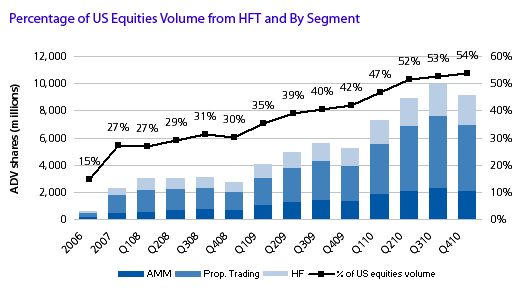Demystifying and Evaluating High Frequency Equities Trading: Fast Forward or Pause?
Abstract
High frequency trading of equities has been a growing trend for some time, though the topic has been rediscovered of late. Enabled by regulatory change, an evolving market structure, and technological innovation in the trading arena, HFT now constitiutes about 42% of daily US equities share volume and is expected to exceed 50% by mid-2010.
Media reports and current SEC investigations have fanned the flames of a debate on high frequency trading (HFT) of equities. Market participants are concerned not only as to who and what constitute HFT, but also with evaluating important market implications of the growing trend, according to a new report, Demystifying and Evaluating High Frequency Equities Trading: Fast Forward or Pause? HFT is a means, not an end in itself, driven by the popularty of certain strategies. Thus, by making assumptions for the current and future propensity for latency-sensitive strategies to be adopted by hedge funds, proprietary trading firms, and electronic market-makers, we estimate that 42% of daily US equity share volume in 4Q09 is related to high-speed, high frequency trading and should grow to 54% by fourth quarter 2010.
"Adoption of HFT will be driven by an expansion of quantitative hedge fund strategies and the growth of proprietary trading firms," says David Easthope, senior analyst with Celent’s Capital Markets group and coauthor of the report. “The convergence of fundamental and quantitative strategies by some firms will mean the coupling of execution and investment strategies, leading to greater HFT adoption even among more traditionally conservative organizations."
"The reality of the evolved electronic environment is that the new trading rules of the game are now based on technology,” adds Chermaine Lee, analyst with Celent’s Capital Markets group and coauthor of the report. “The buy side can counteract the loss of a competitive edge by optimizing the use of execution algorithms and adjusting execution strategies more regularly."
HFT exhibits regional variations, with Asia and Latin America demonstrating signs of the adoption of higher speed, high-turnover trading in the next few years. However, more heavy-handed regulation and comparatively lagging market structure, including exchange matching systems, will be barriers to adoption of certain strategies. In this report, Celent evaluates the impact of HFT and highlights pros and cons. The report also examines liquidity provisioning from automated market-making, latency and technological competition, intraday volatility, and market impact costs.

